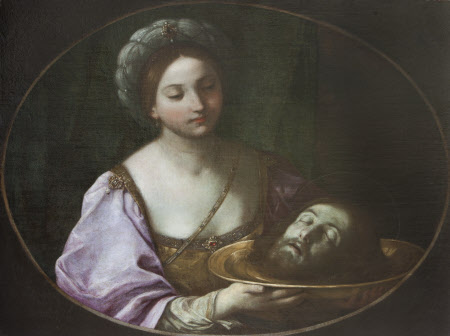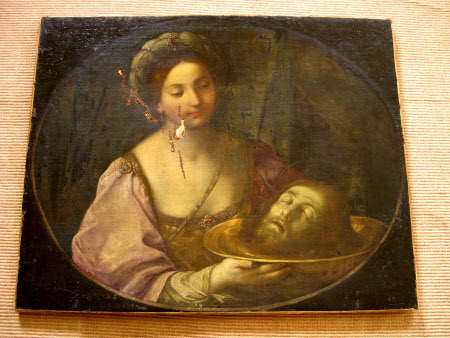Salome holding the Head of John the Baptist on a Charger
after Giovanni Andrea Sirani (Bologna 1610 – Bologna 1670)
Category
Art / Oil paintings
Date
1600 - 1699
Materials
Oil on canvas
Measurements
685 x 838 mm
Place of origin
Italy
Order this imageCollection
Belton House, Lincolnshire
NT 436262
Summary
Oil painting on canvas (horizontal oval), Salome holding the Head of John the Baptist on a Charger by a follower of Guido Reni (Bologna 1575 – Bologna 1642) or by or after Giovanni Andrea Sirani (Bologna 1610 – Bologna 1670). This is one of various versions of a composition that has been optimistically ascribed to Guido Reni but is in fact by a close follower of Giovanni Andrea Sirani (1610 - 1670). It was acquired by Sir John Brownlow, 5th Bt, later Viscount Tyrconnel (1690-1754). Elizabeth Cust (1776 - 1858) compiled a catalogue of Belton's pictures for her uncle by marriage, Philip I Yorke of Erddig. Elizabeth Cust painted a bowdlerised copy of the present picture, which she appears to have given to her aunt and namesake, the wife of Philip I Yorke of Erddig, where it still remains. It was somewhat confusedly called ‘Daughter of Herodias. Hon.ble Miss Cust from a picture by Pizzone’, in an early nineteenth century inventory of the house – confusedly, not only because of the non-existent artist’s name, but also because, in her copy, she replaced the placid head of John the Baptist with a couple of Barbary Doves in a basket (that they are Barbary Doves was established by the flurry of letters that descended on the present writer’s head when, writing about this picture in the National Trust Magazine in Autumn 1997, he referred to them as Collared Doves, which did not reach the UK until the 1950s). The subject (for possibly Freudian reasons, that it might be rash to embark upon the analysis of here) is one that appears to have appealed to gently-born Victorian daughters, since the National Trust recently bought – to prevent its leaving Chirk Castle – an unbowdlerised copy by Fanny Mostyn Owen, Mrs. Myddleton Biddulph (though this was of another version of the picture, that then belonged to John Mytton of Halston). The picture is not without its own intrinsic interest, since the composition, whilst deriving from a celebrated three quarter-length by Guido Reni himself, that was in the Barberini and Corsini collections, before being acquired with the latter by the Galleria Nazionale d’Arte Antica in Rome, evidently enjoyed considerable popularity. Another such oval was in the Orléans Collection as by Guido Reni, but had also been reattributed to Elisabetta Sirani by the time of its last known appearance, in Charles Butler’s sale in 1911. Besides the version in the collection of John Mytton of Halston, there was another in that of Reginald Cholmondeley of Condover, which was also ascribed to Elisabetta Sirani. Such an attribution can be ruled out – but it was a common nineteenth century mistake to think that Elisabetta, rather than her father, Giovanni Andrea Sirani (Bologna 1610-1670), was the pasticheur of Guido Reni. An attribution to him, of this painting or of its original (until it is cleaned it is impossible to say whether or not it might itself be that original), is well worth entertaining.
Provenance
Bought at Christie's, 22 April 2005, lot 115 with Belton special funds and money from the Sugden bequest
Credit line
Belton House, The Brownlow Collection (acquired with the help of the National Heritage Memorial Fund by the National Trust in 1984)
Makers and roles
after Giovanni Andrea Sirani (Bologna 1610 – Bologna 1670), artist previously catalogued as follower of Guido Reni (Bologna 1575 – Bologna 1642), artist

